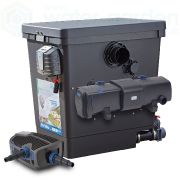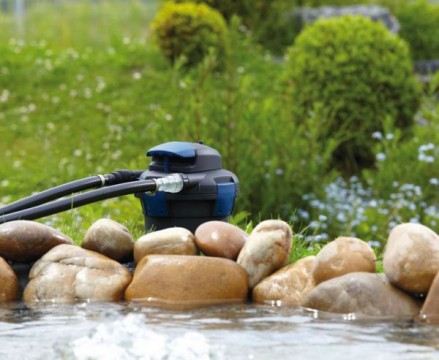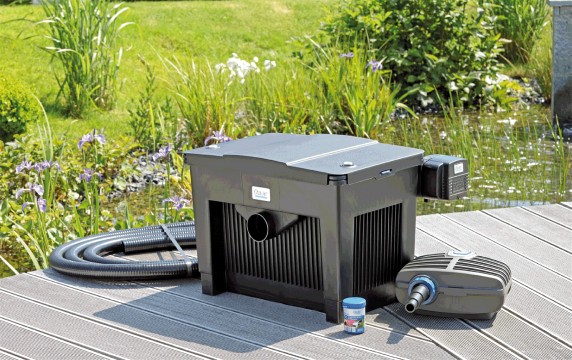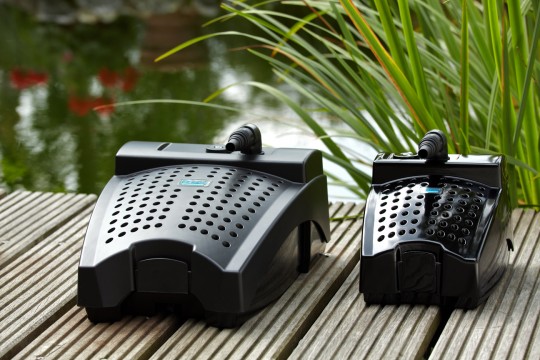Quick Tip: Use our new Pond Filters Wizard to help you select the exact pond filter you need.
Do I need a filter for my pond?

Your pump and pond filter play a vital role in keeping your pond healthy and attractive. They serve to maintain your pond’s ecological balance, and when combined with a surface skimmer, they help to remove leaves and other debris that have fallen into the water. Your filter will also keep algae growth under control. All of this works together to ensure that the fish and plants in your pond or water garden thrive and remain healthy.
At Water Garden, we supply our customers with German-engineered OASE pond filters. The models that we stock have a proven track record, and they incorporate market-leading technology. We stock several types and sizes of filters so that you can find precisely the model that you need to maintain a healthy filtration system in your garden pond.
In this post, we’re going to provide you with advice on choosing the right size of filter for your pond. But before we get into that, let’s take a moment to consider the different types of filters available.
What Type of Pond Filter Do I Need?
When you are shopping around for a filter, you’ll come across two different types of mechanisms:
- Ultraviolet Clarifier
- Biological Filter
 Some people speak as if these are actually two different types of filters, but that’s not really how it works. A biological filter is the actual filtration system. While the skimming system works to remove larger debris such as leaves from the water, the biological filter operates on a much smaller scale. It removes soluble organic and particulate waste matter from the water. Once the water is cleansed, it is returned to the pond.
Some people speak as if these are actually two different types of filters, but that’s not really how it works. A biological filter is the actual filtration system. While the skimming system works to remove larger debris such as leaves from the water, the biological filter operates on a much smaller scale. It removes soluble organic and particulate waste matter from the water. Once the water is cleansed, it is returned to the pond.
A UV clarifier sterilises and clarifies the water. This is a particularly important mechanism for getting rid of algae. As the water is pumped through the clarifier, small bits of live algae are passed in front of ultraviolet light. This causes the algae to come apart on a cellular level – killing them. The algae then clump together in larger masses that can be pulled out of the water by the biological filter.
When a product is advertised as a ‘UV filter’, what this really means is that the biological filter works in conjunction with a UV clarifier to clean the water and remove living algae. We have many biological filters with a UV component in our shop, beginning with our entry-level BioPress pressurised filter.
Remember: There’s No Such Thing as Over-Filtration

Proper filtration ensures that your pond remains clear throughout the year, and it keeps your fish and plants healthy. Before we get into the specifics of determining what size filter you need, we should note that there is no such thing as ‘over-filtration’. You simply cannot harm the ecosystem with an oversized filter. When in doubt, it never hurts to opt for the larger model. This ensures that your pond remains clean, clear and healthy – without posing any risk to the lifeforms you keep in it.
Inadequate filtration, on the other hand, can quickly lead to murky water. This can actually kill the fish and plants that live in it. At the same time, a filter that is not cut out for the job is not going to keep algae under control. If your filtration system is not big enough, you’re going to end up raising algae rather than the ornamental plants you had intended for this space.
Choosing the Right Size Filter for Your Pond
There are several factors that affect the size of filter that is going to be best-suited to your pond:
- Shape of the pond
- Volume of water in the pond
- Physical location of the pond on your property
- Number of fish in the pond
- Number of plants in the pond
As a general rule, the minimum requirement for a pond would be a filter that is able to process the entire volume of the pond in 8 hours. This would be sufficient for an un-stocked pond, but very few people go to the trouble of installing a pond without adding plants and animals to it.
Here are the steps for choosing the right-sized filter for your pond:
- Measure the dimensions of your pond.
Measure the width, length and depth of your pond in metres. If it is circular, measure the diameter and radius. For odd-shaped ponds, just take as many measurements as you can. It helps to draw a diagram in this case.
- Determine the pond’s volume.
For a square or rectangular pond, all you would need to do is multiply the length, width and depth of the pond, taking these measurements in metres. Multiply this figure by 1,000 to determine how many litres of water your pond holds.
For a circular pond, use 3.14, multiply that figure by radius x radius by the depth. For odd-shaped ponds (as most are), you are best breaking it up into different sections that are easier to work with. Simply add the respective volumes of each section together at the end.
- Compensate for various factors.
Once you have the actual volume of the pond, it is time to make adjustments for various other factors. To begin with, if your pond is less than 750 cm deep, the filter will need to work harder. Multiply the volume by 1.25 to compensate. If the pond is in the open sunlight, multiply the figure by 1.25 again. Climate also needs to be taken into account. For more temperate climates, multiply the effective volume again by 1.15.
Take fish into account.

Next, make adjustments based on the number of fish. If you have around 1kg fish per 1,000 litres of water, no further adjustments are needed. If you have a greater stock of fish than this, call us to speak with a representative, and we’ll help you determine how much you should compensate.
Each time you multiple by one of the factors mentioned above, the new total becomes your ‘effective volume’. If you multiply by several factors, then the effective volume goes up each time. Once you have determined your effective volume, round this figure up to determine the calibre of filter you require.
Admittedly, this process is a bit complex. If you have any questions, please don’t hesitate to contact us. Just be sure to have the dimensions of your pond ready, and we’ll help determine what size filter you need.
Also feel free to use our new Pond Filters Wizard which will help you to select the exact pond filter you need.






